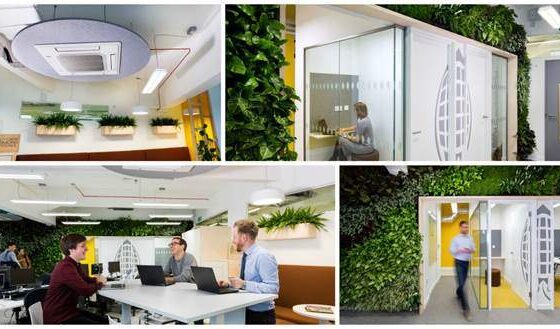

Environment
Office Refurbishment Sets Carbon Footprint Record
The lowest embodied carbon footprint ever recorded for an office refurbishment in the UK has been reached by an office in Central London, home to the UK Green Building Council (UK-GBC)
The project is an exemplar for sustainable office refurbishment and also features a range of innovative wellbeing measures, delivering a space that is both better for people, and better for the environment.
UK-GBC hopes that this landmark project will inspire and encourage employers, landlords and occupiers alike to set the bar high when upgrading their office spaces. It demonstrates that even a 160m² floorspace can deliver phenomenal commercial, social and environmental value if each decision is challenged and scrutinised.
The design and delivery team, led by Barr Gazetas, worked in collaboration with a carbon profiling specialist to ensure that opportunities to reuse, recycle and responsibly source were maximised.
Key stats:
· 139 kgCO2/m² – Embodied carbon footprint 22% below a comparable “standard” fit-out and the lowest ever recorded in the UK (SCP database, WRAP database)*
· 48% decrease in carbon emissions from lighting
· 99.4% of construction waste diverted from landfill
· 98% of original fixtures and finishes reused or repurposed
Wellbeing measures have been incorporated into the design in order to improve staff satisfaction, productivity and overall health and wellness. These measures include: a beautiful living wall with over 1,500 plants; an innovative ventilation system, which has delivered a 750% increase in background fresh air provision; an automated low-energy LED lighting system; and products and finishes that minimise (and in some cases actively remove) pollutants from the air.
The space is designed to accommodate a variety of working styles and agile working choices, including an open plan working area based on hot-desking; a sound-proof ‘telephone booth’ for private calls; a height-adjustable standing meeting table and several softer break-out spaces for informal discussions and social interaction.
UK-GBC’s purpose is to accelerate the transformation of places so that people and planet can thrive.
Julie Hirigoyen, chief executive of UK-GBC said:
“UK-GBC’s purpose is to accelerate the transformation of places so that people and planet can thrive. In refurbishing our own office space, we had a fantastic opportunity to trial and showcase the very best solutions sourced from our membership. I’m delighted at the outstanding results we have achieved – both to minimise our environmental footprint and to improve the wellbeing and productivity of our staff.
“I’d like to thank all of our innovative product suppliers as well as our outstanding design and delivery team: architect, Barr Gazetas; services engineer and sustainability consultant, Cundall; project manager and quantity surveyor, Currie & Brown; main contractor, Morgan Lovell; and carbon consultant, Sturgis Carbon Profiling.”
Tom Lacey, director of Barr Gazetas said:
“As well as being a testbed where every component and output has been scrutinised and monitored, the project is an inspiring, healthy and comfortable place to work. To have achieved such lofty technical targets whilst making a genuine difference for the people who use the space has been a rich learning experience that will have an effect on all our future work.”
In order to maximise the opportunities to learn from this refurbishment, the office will be subject to a post-occupancy evaluation to assess its operational performance against performance factors such as energy efficiency and air quality. Staff satisfaction will be evaluated through ongoing surveys, the results of which will be compared against data collected prior to the refurb. UK-GBC will also be producing content designed to help built environment professionals learn from the project, with a focus on how the design team’s innovative and collaborative ways of working meant that the project was able to achieve its ambitious goals.































